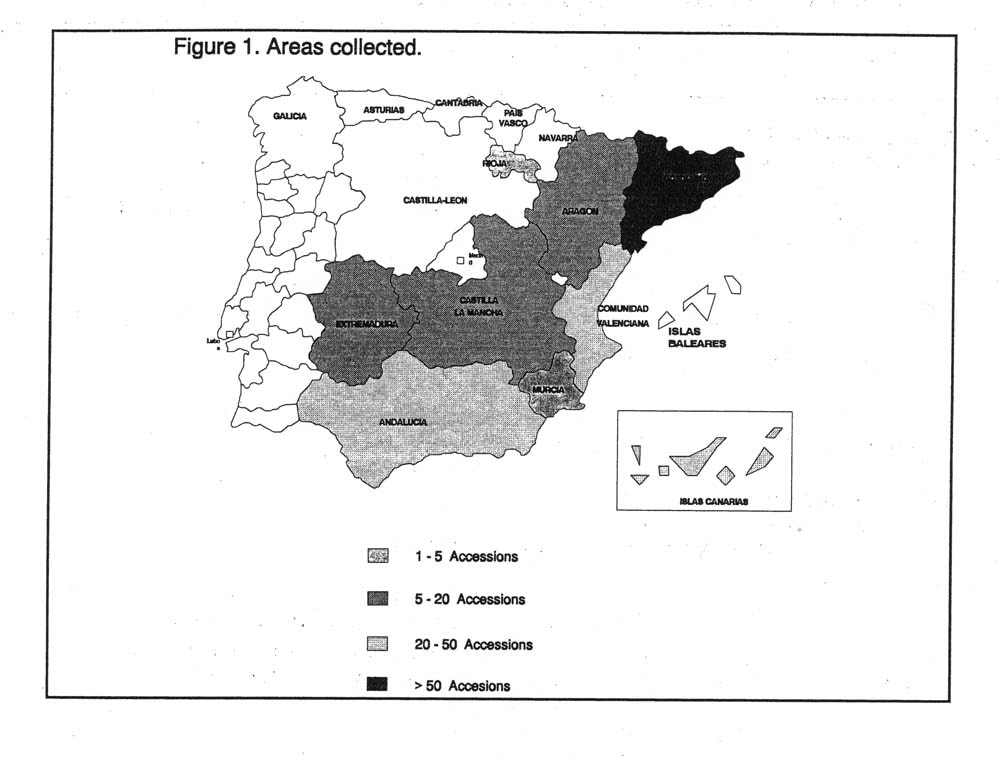Cucurbit Genetics Cooperative Report 18:52-54 (article 25) 1995
Fernandez de Cordova, P., M.J. Diez, A. Iglesias and F. Nuez
Departmento de Biotechnologia, Universidad Politecnica de Valencia, 46022, Valencia, Spain
The Genebank of the Polytechnic University of Valencia holds 5436 accessions of vegetable species. Of these, 2221 of them belong to the Cucurbitaceae, 201 of which are watermelon (Citrullus lanatus (Thunb.) Matson and Nakai). Approximately one third of the accessions have already been characterized, with the others in the process of characterization.
Most of the watermelon accessions were collected in Spain. Some of them come from Latin-America, the Mediterranean basin and a few from other countries (1, 3, 4). An important number of accessions were collected in the states of Cataluna (27% of accessions), Valencia (18%), Canarias (16%) and Andalucia (14%) (Fig. 1). Andalucia and Valencia are the two principal watermelon producers in Spain. In these areas, and in Cataluna, the majority of the crop is irrigated. Extremadura and Castilla-La Mancha occupy third and fourth places, respectively, in relation to yield. Nevertheless, this is a secondary crop in these areas and is grown as a dry land crop.
The following are the characteristics recorded in field trials:
- Fruit characteristics: shape, skin color, spots on the skin, blossom scar, weight, longitudinal and transverse sections, skin width, flesh color,.color of the cortical zonal and 0 Brix.
- Vegetative characteristics: leaf length and width, number of leaf lobes, shape of the first lobe (double or single), width of the lobes.
- Other agricultural characteristics: fruit set, set homogeneity, number of fruits per plant, agricultural interest.
Accessions regenerated and characterized have been classified into groups, depending on fruit weight, shape, skin color, flesh color and seed coat color (2, 5). Table 1 shows the accessions grouped by fruit size, and their place of origin.
Table 1. Characteristics of Citrullus lanatus accessions grouped by fruit size.
Shape |
Skin color |
Fruit surface |
Flesh color |
Seed coat color |
Accessonsz |
Small-fruited accessions (<4 kg) |
|||||
| globular | light green | netted, lighter | white | black | CA-CI-4 |
| pink | tan | V-CI-17 | |||
| black | CA-CI-2, CA-CI-7, V-CI-3, V-CI-14, V-CI-30-A-CI-3 | ||||
| dark green | smooth | pink | tan | MU-CI-3 | |
| red | black | AN-CI-10, AN-CI-13 | |||
| netted, darker | pink | tan | MU-CI-2, AN-CI-1, AN-CI-15, CL-CI-11, V-CL-33 | ||
| oval | light green | netted, darker | white | tan | AN-CI-26-(1) |
| black | AN-CI-26-(2) | ||||
| pink | black | V-CI-31, CM-CI-6, CM-CI-11-(1) | |||
| dark green | smooth | pink | tan | E-CI-4, A-CI-4 | |
Medium-fruited accessions (4-6 kg) |
|||||
| globular | light green | smooth | red | tan | AN-CI-7 |
| netted, darker | white | tan | CM-CI-I | ||
| black | V-CI-32 | ||||
| yellow | black | AN-CI-14 | |||
| pink | black | AN-CI-16, AN-CI-2, V-CI-21, CM-CI-7-(1) | |||
| red | black | AN-CI-25, V-CI-16-(1), V-CI-16-(2) | |||
| dark green | smooth | pink | tan | V-CI-18, CM-CI-2, AN-CI-14 | |
| black | A-CI-6 | ||||
| red | white | C-CI-I | |||
| red | tan | CA-CI-8-, CM-CI-11-(2) | |||
| red | black | C-CI-3 | |||
| netted, lighter | red | tan | CM-CI-7-(2) | ||
| netted, darker | red | black | AN-CI-6-V-CI-16-(2) | ||
| elliptical | light green | netted, darker | pink | tan | 11620 |
Large-fruited accessions (608 kg) |
|||||
| globular | light green | smooth | red | black | 11621, 10357 |
| netted, darker | red | black | CA-CI-17 | ||
| elliptical | light green | smooth | pink | tan | CA-CI-5 |
Very-large-fruited acessions (8012 kg) |
|||||
| globular | dark green | smooth | pink | black | CA-CI-1 |
| elliptical | light green | smooth | pink | black | 10198 |
| netted, lighter | pink | tan | 10278 | ||
| red | black | V-CI-15, 9599 | |||
zIn the accessions collected in Spain, the first letters of the code indicate the place of origin: Aragon (A), Andalucia (AN), Cataluna (C), Castilla-La Mancha (CM), Castilla-Leon (CL), Extremadura (E), Murcia (MU), and Valencia (V). An exclusively numeric code has been given to accessions coming from other countries.
Figure 1. Areas collected.

Acknowledgements: Expeditions for material collecting for the Polytechnic University of Valencia Genebank have been subsidized by IBPGR and INIA.
Literature Cited
- Iglesias, A., M.J. Diez and F. Nuez. 1994. Recursos Genetiocos de Cucurbitaceas en el Banco de Germoplasma de la U.P.V. Actas de Horticultura 12:85-89.
- International Organization for Standardization, Fruits and Vegetables. 1989 Morfological and structural terminology, Part 2. International-Standard: 1965-2; 1989, 31 pp.
- Nuez, F., M.J. Diez, G. Palomares, C. Ferrando, J. Cuartero and J. Costa. 1987. germplasm resources of Citrullus lanatus (Thunb.) Matson and Nakai from Spain. Cucurbit Genet. Coop. Rept. 10:64-65.
- Nuez, F., P. Fernandez de Cordova and M.J. Diez. 1992. Collecting vegetable germplasm in the Canary Islands. FAO/IBPGR. Plant Genetic Resources Newsletter 90:34-35.
- Trisonthi, C. 1992. Description and identification key for some edible tropical fruit. Fruits 47:425-449.